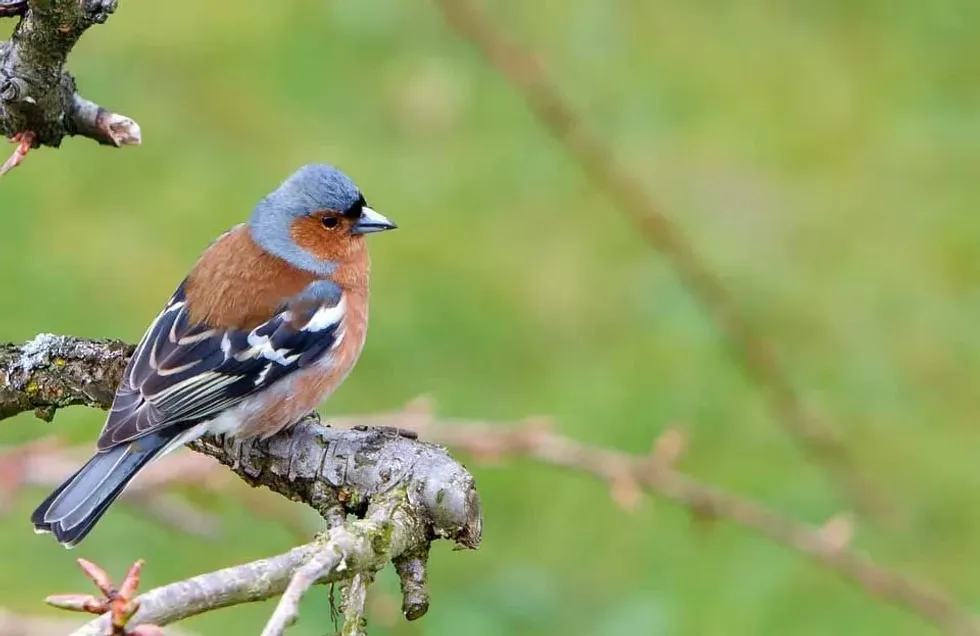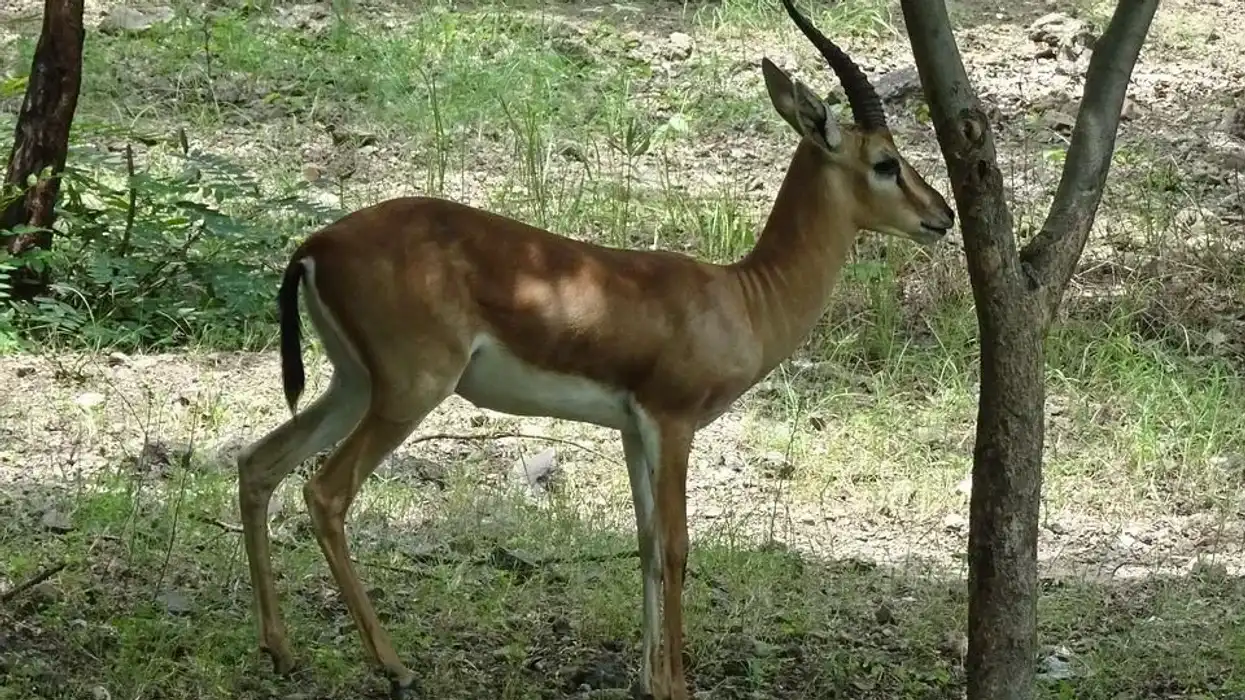A chaffinch (Fringilla coelebs), is a common songbird from the Fringillidae family of the Aves class. They have 18 subspecies, including the Tenerife chaffinch and more.
They are found in Asia, England, Scotland, Ireland, New Zealand, South Africa, and Australia. In winter, a part of their population travels to warmer territories towards the south. It has been observed that females tend to migrate further to the south, compared to males.
They mostly live in forests, woodlands, shrublands, farmlands, and even in parks and gardens of semi-urban or urban areas. So don't get surprised if you spot some chaffinches singing in your garden!
A male chaffinch looks stunning with its vibrant colors. Females are comparatively less appealing than males.
However, similar to the male birds, females also have white-colored feathers on their outer tails. Their breeding period begins in late April, and four to five eggs are laid in one clutch. The breeding pair takes care of the chicks until they gain independence.
To learn more, we have collected a set of interesting facts about chaffinches for you to read. You can also learn more about fascinating wild animals and birds by reading up more articles on the European goldfinch and the verdin.
Chaffinch Interesting Facts
What type of animal is a chaffinch?
Chaffinch birds, also known as the common chaffinch (Fringilla coelebs) are one of the most popular songbirds in the world. They belong to the Fringilla genus.
What class of animal does a chaffinch belong to?
Chaffinches belong to the Aves class of the Animalia kingdom.
How many chaffinches are there in the world?
Chaffinches are one of the most widespread birds. Therefore, finding exact statistics of their population is difficult. There are approximately 530-767 million individuals living around the world.
Where does a chaffinch live?
This bird species resides in central and western Asia, England, Ireland, and northwestern Africa. In the 19th century, they debuted in South Africa, New Zealand, and, more recently in Australia. A few subspecies are located in the islands of the Atlantic Ocean, such as Madeira and the Canary Islands.
They are a partly migratory species, but chaffinches living in England, Scotland, and Ireland do not migrate. During the winter period, chaffinches living in the far north fly to warmer habitats.
What is a chaffinch's habitat?
Chaffinches live in forests, woodlands, shrublands, gardens, parks, and farmlands. They are frequently spotted in parks, and gardens of urban or semi-urban areas. They can be found in your backyard, on a tree, or in a bush.
Who do chaffinches live with?
Chaffinches form small flocks and live in harmony. Together they travel to southern territories in winter. Ornithologists consider them as the most gregarious songbirds. A flock of chaffinches is also known as a 'charm' of chaffinches.
How long does a chaffinch live?
Depending on their diet and habitat, a chaffinch bird can live for between 3-15 years. The longest living common chaffinch, who was native to Switzerland, roamed around this world for 16 years!
How do they reproduce?
Chaffinch birds practice a monogamous mating system. Their breeding season takes place between late April and mid-June.
Females take the lead in making their nest and they nest in forks of trees. They built their nest with feathers, twigs, dried leaves, spider webs, and thin roots. The female chaffinch is smart enough to cover it with moss and lichens to protect it from predators.
Females lay between four and five eggs per clutch after an incubation period of 10-16 days. The chicks gain their independence 32-39 days after birth. Both the female and male chaffinch feed their chicks, who gain their sexual maturity at the age of 12 months.
What is their conservation status?
The International Union for Conservation of Nature (IUCN) Red List has categorized them as a Least Concern species.
Chaffinch Fun Facts
What do chaffinches look like?
A male common chaffinch bird is a visual treat to ornithologists. These small-sized birds have a blue-gray-colored head, olive green-colored rump, rusty brown breasts, and black and white wing bars. Female chaffinches are comparatively less appealing than males. They have a greenish-brown head, olive green rump, and white tail feathers.
How cute are they?
Chaffinches are one of the cutest birds of the finch family. Especially the males, with their striking bright colors.
How do they communicate?
Similar to other birds, they communicate by making various sounds and calls. Chaffinches can perform eight different calls. A chaffinch bird has a beautiful voice and they used to be a very popular songbird in earlier times.
How big is a chaffinch?
They are typically 4.7-5.7 in (12-14.5 cm) in length with a wingspan of 9.6-11.2 in (24.5-28.5 cm). They are almost similar to sparrows in size.
How fast can a chaffinch fly?
Like other finches, they fly by continuously flapping their wings, and even though the exact speed of these birds is not known, we know that they fly at a moderate to fast speed.
How much does a chaffinch weigh?
Depending on their diet and habitat, these little birds weigh around 0.6-1 oz (18-29 g).
What are their male and female names of the species?
A male chaffinch bird is called a 'cock', and a female is called a 'hen'.
What would you call a baby chaffinch?
A baby chaffinch is called a 'chick'.
What do they eat?
Common chaffinches are omnivorous birds. However, they are more interested in their carnivorous diet during the breeding season. Their diet includes grubs, caterpillars, small insects, spiders, and earwigs. The rest of the year this bird consumes seeds, berries, and grains as well.
Are they dangerous?
These birds do not show any tendency of unfriendliness or aggression unless they are trying to protect their nests. Otherwise, they are very friendly.
Would they make a good pet?
They are very popular pet birds in European ranges. They are friendly, and easy to tame compared to others.
Did you know...
Cats and sparrowhawks are considered the worst enemies of the common chaffinch. They eat adult chaffinches, as well as chicks and eggs.
They are also known as the 'bachelor bird', as their flocks mostly consist of birds of the same gender.
Chaffinches are especially fond of oak trees when it comes to nesting places.
The Tenerife blue chaffinch bird is a distinguished member of their species due to its striking blue-colored feathers. They can be only found on the Canary Islands.
The chaffinch's call
The chaffinch's song and call are pleasant and soothing to hear. They can perform various songs and calls and have multiple dialects as well. Their usual call sounds like 'pink-pink'. They often express their emotions by mixing multiple calls.
How to pronounce 'chaffinch'
The name 'chaffinch' is very easy to pronounce. You just need to pronounce it 'cha-fuhnch'. Easy, right?
Here at Kidadl, we have carefully created lots of interesting family-friendly animal facts for everyone to discover! Learn more about some other birds including the long-tailed tit, or the common blackbird.
You can even occupy yourself at home by drawing one on our goldfinch coloring pages.










